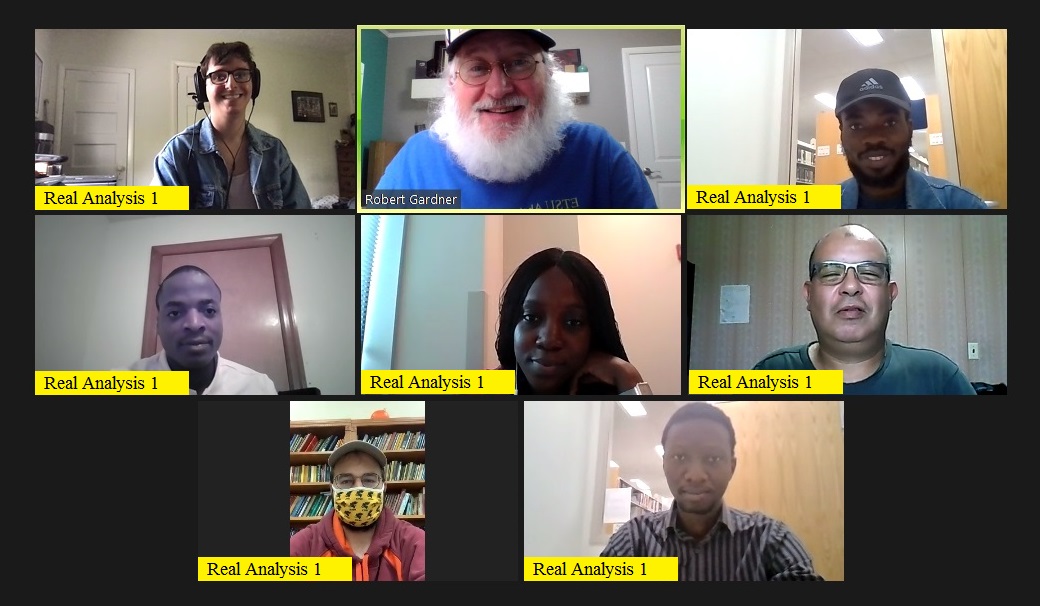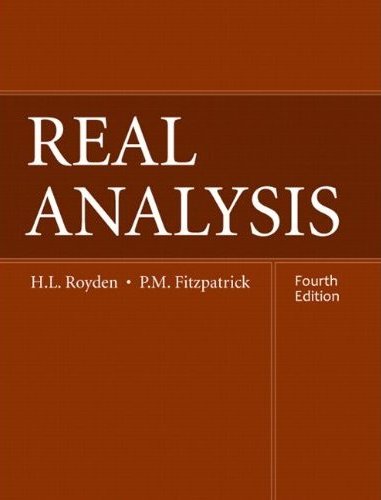


COURSE: MATH 5210-001
TIME: 2:15-3:35 TR, PLACE: Online through Zoom
INSTRUCTOR: Dr. Robert Gardner, OFFICE: Room 308F of Gilbreath Hall
OFFICE HOURS: By appointment (I can be available after class on TR), PHONE: 439-6979 (Math Office 439-4349)
E-MAIL: gardnerr@etsu.edu
WEBPAGE: http://faculty.etsu.edu/gardnerr/gardner.htm
TEXT: Real Analysis, Fourth Edition, by H.L. Royden and P.M. Fitzpatrick, Prentice Hall (2010).

CLASS NOTES: We will use digital notes for the component of the lecture consisting of definitions, statements of theorems, and some examples. Proofs of the vast majority of theorems, propositions, lemmas, and corollaries are available and in Beamer presentations and will be presented in class as time permits. Limited marginal notes, additional examples, and further explanations will be given using handwritten notes and a document camera. Copies of the notes are online at: http://faculty.etsu.edu/gardnerr/5210/notes1.htm. You should read the online notes to be covered in class before each class (we may not have class time to cover every little detail in the online notes). Try to understand the definitions, the examples, and the meanings of the theorems. After each class, you should read the section of the book covered in that class, paying particular attention to examples and proofs.
VIDEOS: Videos for some of the material covered in this class will be posted online. Videos are posted both on my faculty server, see Real Analysis 1 online videos on the ETSU server and on Zoom, see Real Analysis 1 online videos on Zoom. Follow either of these links for more details.
ABOUT THE COURSE: This class offers a standard introduction to the theory of functions of a real variable from the measure theoretic perspective. As commented on page 1 of the third edition of Real Analysis, we will cover "a portion of the material that every graduate student in mathematics must know." Whereas the undergraduate real analysis class presents the results of calculus from a rigorous perspective, we will introduce fundamentally new ideas which are basic extensions of the results from calculus. In particular, we will put a weight or "measure" on certain sets of real numbers. This measure will be used to define a new type of integral called the Lebesgue integral. Recall that a function is Riemann integrable if and only if it is discontinuous on a "small" set (namely, a set of measure zero). The Lebesgue integral is much more flexible and will allow us to integrate a much larger class of functions. In addition, we will have a number of "convergence theorems" related to the Lebesgue integral, which are not true in the setting of Riemann integration. The fourth edition of Real Analysis states on page x that "The general theory of measure and integration was born in the early twentieth century. It is now an indispensable ingredient in remarkably diverse areas of mathematics, including probability theory, partial differential equations, functional analysis, harmonic analysis, and dynamical systems. Indeed, it has become a unifying concept."
GRADING: Since this is an online class, your grade will be determined by the average on the assigned homework exercises. Grades will be assigned based on a 10 point scale with "plus" and "minus" grades being assigned on a 3 point subscale (for example, a 90, 91, 92 is an A-). Remember that the lowest passing grade in a graduate course is a C, so you need an average of 73% on all assignments in order to pass this class.
HOMEWORK: Homework will be assigned and collected at roughly one week intervals. YOU MUST SHOW ALL DETAILS ON THE HOMEWORK PROBLEMS!!! Justify every step and claim you make - this is how you convince me that you know what you are doing. You may find some answers online, but these rarely sufficiently justify all steps and are unacceptable as homework solutions.
ACADEMIC MISCONDUCT: While I suspect that you may work with each other on the homework problems, I expect that the work you turn in is your own and that you understand it. Some of the homework problems are fairly standard for this class, and you may find proofs online or in an online version of the solutions manual. The online proofs may not be done with the notation, definitions, and specific methods which we are developing and, therefore, are not acceptable for this class. If I get homework from two (or more) of you that is virtually identical, then neither of you will get any credit. If you copy homework solutions from an online source, then you will get no credit. These are examples of plagiarism and I will have to act on this as spelled out on ETSU's "Academic Integrity @ ETSU" webpage (last accessed 7/22/2020). To avoid this, do not copy homework and turn it in as your own!!! Even if you collaborate with someone, if you write the homework problems out in such a way that you understand all of the little steps and details, then it will be unique and your own work. If your homework is identical to one of your classmates, with the exception of using different symbols/variables and changing "hence" to "therefore," then we have a problem! If you copy a solution from a solution manual or from a website, then we have a problem! I will not hesitate to charge you with academic misconduct under these conditions.
DESIRE2LEARN: I will not rely on the Desire2Learn ("elearn") website. Instead, I will simply post all material directly on the internet. However, I will post your homework grades on D2L.
SYLLABUS ATTACHMENT: You can find an on-line version of the university's syllabus attachment (which contains general information concerning advisement, honor codes, dropping, etc.; last accessed 7/22/2020).
TENTATIVE OUTLINE:
Essential Background for Real Analysis I
Real numbers, field, ordering, least upper bounds, completeness, Cauchy sequences, lim sup, lim inf, open, closed, compact, connected, Heine Borel Theorem, cardinality, countable/uncountable, Cantor's Theorem, Continuum Hypothesis.
The Riemann-Lebesgue Theorem
Riemann integral, measure zero set, oscillation, uniform convergence, convergence theorems.
Chapter 1: The Real Numbers (Section 4)
σ-algebras of sets, Borel sets, Fσ and Gδ sets.
Chapter 2: Lebesgue Measure
outer measure, measurable sets, inner approximation, Lebesgue measure, nonmeasurable set, Banach-Tarski Paradox, Cantor set and Cantor-Lebesgue Function.
Axiom of Choice: More Axiom of Choice and the Banach-Tarski Paradox.
Chapter 3: Lebesgue Measurable Functions
measurable functions, characteristic functions, approximation, Littlewood's principles, Egoroff's Theorem, Lusin's Theorem.
Chapter 4: Lebesgue Integration
Riemann integral, step functions, simple functions, Lebesgue integral of a
bounded function, Bounded Convergence Theorem, Fatou's Lemma, Monotone
Convergence Theorem, Lebesgue Dominated Convergence Theorem, general Lebesgue
integral, uniform integrability.
SYLLABUS ATTACHMENT: You can find an on-line version of the university's syllabus attachment (which contains general information concerning advisement, honor codes, dropping, etc.; last accessed 3/13/2020).
IMPORTANT DATES: (see the official ETSU calendar for more details; accessed 7/22/2020):
| |
|
||||
| |
|||||
| |
|||||
| |
2.1 Intro to Measure |
2.3 |
|||
| |
|||||
| |
|||||
| |
|||||
| |
2.6 Nonmeasurable Sets |
2.6.A, 2.6.B, 2.6.C |
|||
| |
|||||
| |
|||||
| |
4.2 The Lebesgue Integral of a Bounded Measurable Function over a Set of Finite Measure |
4.9, 4.11 |
|||
| |
4.3 The Lebesgue Integral of a Measurable Nonnegative Function |
4.25, 4.27 |
|||
Return to Bob Gardner's home page
Last updated: November 8, 2020